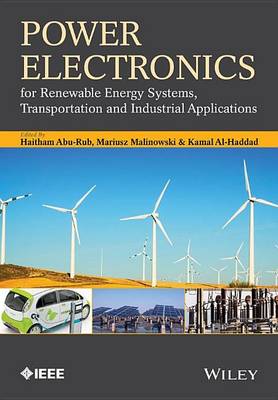Wiley - IEEE
5 total works
Power Electronics for Renewable Energy Systems, Transportation and Industrial Applications
by Haitham Abu-Rub, Mariusz Malinowski, and Kamal Al-Haddad
PHEV power system architectures and advanced power electronics intensive charging infrastructures for EVs and PHEVs are detailed. EV/PHEV interface with renewable energy is described, with practical examples. This book explores new topics for further research needed world-wide, and defines existing challenges, concerns, and selected problems that comply with international trends, standards, and programs for electric power conversion, distribution, and sustainable energy development. It will lead to the advancement of the current state-of-the art applications of power electronics for renewable energy, transportation, and industrial applications and will help add experience in the various industries and academia about the energy conversion technology and distributed energy sources. It combines state of the art global expertise to present the latest research on power electronics and its application in transportation, renewable energy and different industrial applications.
It offers an overview of existing technology and future trends, with discussion and analysis of different types of converters and control techniques (power converters, high performance power devices, power system, high performance control system and novel applications). Systematic explanation to provide researchers with enough background and understanding to go deeper in the topics covered in the book.
Impedance Source Power Electronic Converters
by Yushan Liu, Haitham Abu-Rub, Baoming Ge, Frede Blaabjerg, Omar Ellabban, and Poh Chiang Loh
Impedance Source Power Electronic Converters brings together state of the art knowledge and cutting edge techniques in various stages of research related to the ever more popular impedance source converters/inverters.
Significant research efforts are underway to develop commercially viable and technically feasible, efficient and reliable power converters for renewable energy, electric transportation and for various industrial applications. This book provides a detailed understanding of the concepts, designs, controls, and application demonstrations of the impedance source converters/inverters.
Key features:
- Comprehensive analysis of the impedance source converter/inverter topologies, including typical topologies and derived topologies.
- Fully explains the design and control techniques of impedance source converters/inverters, including hardware design and control parameter design for corresponding control methods.
- Presents the latest power conversion solutions that aim to advance the role of power electronics into industries and sustainable energy conversion systems.
- Compares impedance source converter/inverter applications in renewable energy power generation and electric vehicles as well as different industrial applications.
- Provides an overview of existing challenges, solutions and future trends.
- Supported by calculation examples, simulation models and results.
Highly accessible, this is an invaluable resource for researchers, postgraduate/graduate students studying power electronics and its application in industry and renewable energy conversion as well as practising R&D engineers. Readers will be able to apply the presented material for the future design of the next generation of efficient power electronic converters/inverters.
Capacitors in Power Electronics Applications
by Huai Wang and Frede Blaabjerg
Variable Speed AC Drives with Inverter Output Filters
by Jaroslaw Guzinski, Haitham Abu-Rub, and Patryk Strankowski
Highly accessible, this is an invaluable resource for practising R&D engineers in drive companies, power electronics & control engineers and manufacturers of electrical drives. Senior undergraduate and postgraduate students in electronics and control engineering will also find it of value.
Smart Grid and Enabling Technologies
by Omar Ellabban, Shady Khalil, Haitham Abu-Rub, Frede Blaabjerg, and Miroslav Begovic
Discover foundational topics in smart grid technology as well as an exploration of the current and future state of the industry
As the relationship between fossil fuel use and climate change becomes ever clearer, the search is on for reliable, renewable and less harmful sources of energy. Sometimes called the “electronet” or the “energy Internet,” smart grids promise to integrate renewable energy, information, and communication technologies with the existing electrical grid and deliver electricity more efficiently and reliably.
Smart Grid and Enabling Technologies delivers a complete vision of smart grid technology and applications, including foundational and fundamental technologies, the technology that enables smart grids, the current state of the industry, and future trends in smart energy. The book offers readers thorough discussions of modern smart grid technology, including advanced metering infrastructure, net zero energy buildings, and communication, data management, and networks in smart grids.
The accomplished authors also discuss critical challenges and barriers facing the smart grid industry as well as trends likely to be of importance in its future development. Readers will also benefit from the inclusion of:
- A thorough introduction to smart grid architecture, including traditional grids, the fundamentals of electric power, definitions and classifications of smart grids, and the components of smart grid technology
- An exploration of the opportunities and challenges posed by renewable energy integration
- Practical discussions of power electronics in the smart grid, including power electronics converters for distributed generation, flexible alternating current transmission systems, and high voltage direct current transmission systems
- An analysis of distributed generation
Perfect for scientists, researchers, engineers, graduate students, and senior undergraduate students studying and working with electrical power systems and communication systems. Smart Grid and Enabling Technologies will also earn a place in the libraries of economists, government planners and regulators, policy makers, and energy stakeholders working in the smart grid field.

